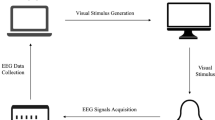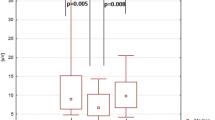Abstract
Purpose
To investigate whether a conventional, monitor-based multifocal visual evoked potential (mfVEP) system can be used to record steady-state mfVEP (ssmfVEP) in healthy subjects and to study the effects of temporal frequency, electrode configuration and alpha waves.
Methods
Multifocal pattern reversal VEP measurements were performed at 58 dartboard fields using VEP recording equipment. The responses were measured using m-sequences with four pattern reversals per m-step. Temporal frequencies were varied between 6 and 15 Hz. Recordings were obtained from nine normal subjects with a cross-shaped, four-electrode device (two additional channels were derived). Spectral analyses were performed on the responses at all locations. The signal to noise ratio (SNR) was computed for each response using the signal amplitude at the reversal frequency and the noise at the neighbouring frequencies.
Results
Most responses in the ssmfVEP were significantly above noise. The SNR was largest for an 8.6-Hz reversal frequency. The individual alpha electroencephalogram (EEG) did not strongly influence the results. The percentage of the records in which each of the 6 channels had the largest SNR was between 10.0 and 25.2 %.
Conclusion
Our results in normal subjects indicate that reliable mfVEP responses can be achieved by steady-state stimulation using a conventional dartboard stimulator and multi-channel electrode device. The ssmfVEP may be useful for objective visual field assessment as spectrum analysis can be used for automated evaluation of responses. The optimal reversal frequency is 8.6 Hz. Alpha waves have only a minor influence on the analysis. Future studies must include comparisons with conventional mfVEP and psychophysical visual field tests.






Similar content being viewed by others
References
Baseler HA, Sutter EE, Klein SA, Carney T (1994) The topography of visual evoked response properties across the visual field. Electroencephalogr Clin Neurophysiol 90(1):65–81
Klistorner A, Graham SL (2000) Objective perimetry in glaucoma. Ophthalmology 107(12):2283–2299
Hood DC, Zhang X, Greenstein VC, Kangovi S, Odel JG, Liebmann JM, Ritch R (2000) An interocular comparison of the multifocal VEP: a possible technique for detecting local damage to the optic nerve. Invest Ophthalmol Vis Sci 41(6):1580–1587
Hood DC, Odel JG, Zhang X (2000) Tracking the recovery of local optic nerve function after optic neuritis: a multifocal VEP study. Invest Ophthalmol Vis Sci 41(12):4032–4038
Graham SL, Klistorner AI, Goldberg I (2005) Clinical application of objective perimetry using multifocal visual evoked potentials in glaucoma practice. Arch Ophthalmol 123(6):729–739
Kaltwasser C, Horn FK, Kremers J, Juenemann A, Bergua A (2011) Objective visual field determination in forensic ophthalmology with an optimized 4-channel multifocal VEP perimetry system: a case report of a patient with retinitis pigmentosa. Doc Ophthalmol 123(2):121–125
Alshowaeir D, Yannikas C, Garrick R, Van Der Walt A, Graham SL, Fraser C, Klistorner A (2015) Multifocal VEP assessment of optic neuritis evolution. Clin Neurophysiol 126:1617–1623
Horn FK, Kaltwasser C, Junemann AG, Kremers J, Tornow RP (2012) Objective perimetry using a four-channel multifocal VEP system: correlation with conventional perimetry and thickness of the retinal nerve fibre layer. Br J Ophthalmol 96(4):554–559
Punjabi OS, Stamper RL, Bostrom AG, Han Y, Lin SC (2008) Topographic comparison of the visual function on multifocal visual evoked potentials with optic nerve structure on Heidelberg retinal tomography. Ophthalmology 115(3):440–446
Laron M, Cheng H, Zhang B, Schiffman JS, Tang RA, Frishman LJ (2010) Comparison of multifocal visual evoked potential, standard automated perimetry and optical coherence tomography in assessing visual pathway in multiple sclerosis patients. Mult Scler 16(4):412–426
Klistorner AI, Graham SL, Grigg JR, Billson FA (1998) Multifocal topographic visual evoked potential: improving objective detection of local visual field defects. Invest Ophthalmol Vis Sci 39(6):937–950
Hood DC, Zhang X, Hong JE, Chen CS (2002) Quantifying the benefits of additional channels of multifocal VEP recording. Doc Ophthalmol 104(3):303–320
Hood DC, Greenstein VC (2003) Multifocal VEP and ganglion cell damage: applications and limitations for the study of glaucoma. Prog Retin Eye Res 22(2):201–251
Mousa MF, Cubbidge RP, Al-Mansouri F, Bener A (2013) The role of hemifield sector analysis in multifocal visual evoked potential objective perimetry in the early detection of glaucomatous visual field defects. Clin Ophthalmol 7:843–858
Lindenberg T, Peters A, Horn FK, Lausen B, Korth M (2004) Diagnostic value of multifocal VEP using cross-validation and noise reduction in glaucoma research. Graefes Arch Clin Exp Ophthalmol 242(5):361–367
Zhang X, Hood DC, Chen CS, Hong JE (2002) A signal-to-noise analysis of multifocal VEP responses: an objective definition for poor records. Doc Ophthalmol 104(3):287–302
Regan D (1989) Human brain electrophysiology: evoked potentials and evoked magnetic fields in science and medicine. Elsevier, New York
Burkitt GR, Silberstein RB, Cadusch PJ, Wood AW (2000) Steady-state visual evoked potentials and travelling waves. Clin Neurophysiol 111(2):246–258
Bakardjian H, Tanaka T, Cichocki A (2010) Optimization of SSVEP brain responses with application to eight-command brain-computer interface. Neurosci Lett 469(1):34–38
Vialatte FB, Maurice M, Dauwels J, Cichocki A (2010) Steady-state visually evoked potentials: focus on essential paradigms and future perspectives. Prog Neurobiol 90(4):418–438
Mandel C, Luth T, Laue T, Rofer T, Graser A, Krieg-Bruckner B (2009) Navigating a smart wheelchair with a brain–computer interface interpreting steady-state visual evoked potentials. Proc Conf Rec IEEE/RSJ Int Conf Intell Robots Syst, St Louis, MO: 1118–1125
Abdullah SN, Vaegan BMY, Maddess T (2012) Contrast-response functions of the multifocal steady-state VEP (MSV). Clin Neurophysiol 123(9):1865–1871
Herrmann CS (2001) Human EEG responses to 1–100 Hz flicker: resonance phenomena in visual cortex and their potential correlation to cognitive phenomena. Exp Brain Res 137(3–4):346–353
Kaltwasser C, Horn FK, Kremers J, Juenemann A (2009) A comparison of the suitability of cathode ray tube (CRT) and liquid crystal display (LCD) monitors as visual stimulators in mfERG diagnostics. Doc Ophthalmol 118(3):179–189
Meigen T, Bach M (1999) On the statistical significance of electrophysiological steady-state responses. Doc Ophthalmol 98(3):207–232
Norcia AM, Tyler CW, Hamer RD, Wesemann W (1989) Measurement of spatial contrast sensitivity with the swept contrast VEP. Vis Res 29(5):627–637
Lin FC, Zao JK, Tu KC, Wang Y, Huang YP, Chuang CW, Kuo HY, Chien YY, Chou CC, Jung TP (2012) SNR analysis of high-frequency steady-state visual evoked potentials from the foveal and extrafoveal regions of human retina. Conf Proc IEEE Eng Med Biol Soc 2012:1810–1814
Vaegan, Elia MA, Zheng J (2007) Optimising steady-state sweep VEPs to stimuli like the central FDT target: comparison to psychophysical thresholds in early glaucoma detection. In: Marmor M, ed XLV ISCEV international symposium—scientific programme, hotel Taj Krishna, Banjara Hills, Hyderabad, India, August 25–29, 2007 Doc Ophthalmol; 115(suppl):12
Vaegan RAMA, Sanderson GF (2008) Glaucoma affects steady-state VEP contrast thresholds before psychophysics. Optom Vis Sci 85(7):547–558
Birca A, Carmant L, Lortie A, Lassonde M (2006) Interaction between the flash evoked SSVEPs and the spontaneous EEG activity in children and adults. Clin Neurophysiol 117(2):279–288
Klimesch W (1999) EEG alpha and theta oscillations reflect cognitive and memory performance: a review and analysis. Brain Res Brain Res Rev 29(2–3):169–195
Garn H, Waser M, Lechner M, Dorfer M, Grossegger D (2012) Robust, automatic real-time monitoring of the time course of the individual alpha frequency in the time and frequency domain. Conf Proc IEEE Eng Med Biol Soc 2012:2227–2231
Klistorner AI, Graham SL (1999) Multifocal pattern VEP perimetry: analysis of sectoral waveforms. Doc Ophthalmol 98(2):183–196
Fortune B, Hood DC (2003) Conventional pattern-reversal VEPs are not equivalent to summed multifocal VEPs. Investig Ophthalmol Vis Sci 44(3):1364–1375
Bradnam MS, Montgomery DM, Evans AL, Keating D, McClure EA, Damato BE, McFadzean R (1996) Objective detection of hemifield and quadrantic field defects by visual evoked cortical potentials. Br J Ophthalmol 80(4):297–303
Bach M, Meigen T (1999) Do’s and don’ts in fourier analysis of steady-state potentials. Doc Ophthalmol 99(1):69–82
Chen CS, Hood DC, Zhang X, Karam EZ, Liebmann JM, Ritch R, Thienprasiddhi P, Greenstein VC (2003) Repeat reliability of the multifocal visual evoked potential in normal and glaucomatous eyes. J Glaucoma 12(5):399–408
Fortune B, Demirel S, Zhang X, Hood DC, Johnson CA (2006) Repeatability of normal multifocal VEP: implications for detecting progression. J Glaucoma 15(2):131–141
Punjabi OS, Stamper RL, Bostrom AG, Lin SC (2008) Repeatability of the multifocal visual evoked potentials in a clinical glaucoma setting. Can J Ophthalmol 43(4):435–440
Perlstein WM, Cole MA, Larson M, Kelly K, Seignourel P, Keil A (2003) Steadystate visual evoked potentials reveal frontally-mediated working memory activity in humans. Neurosci Lett 342:191–195
Gray M, Kemp AH, Silberstein RB, Nathan PJ (2003) Cortical neurophysiology of anticipatory anxiety: an investigation utilizing steady-state probe topography (SSPT). Neuroimage 20:975–986
Author information
Authors and Affiliations
Corresponding author
Ethics declarations
Conflicts of interest
The authors declare that they have no conflicts of interest.
Funding
No funding was received for this research.
Rights and permissions
About this article
Cite this article
Horn, F.K., Selle, F., Hohberger, B. et al. Steady-state multifocal visual evoked potential (ssmfVEP) using dartboard stimulation as a possible tool for objective visual field assessment. Graefes Arch Clin Exp Ophthalmol 254, 259–268 (2016). https://doi.org/10.1007/s00417-015-3214-9
Received:
Revised:
Accepted:
Published:
Issue Date:
DOI: https://doi.org/10.1007/s00417-015-3214-9




